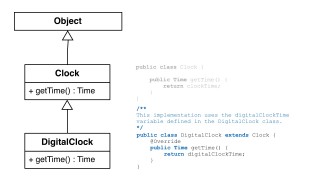How to override a method in Java – J030
Transcript – How to override a method in Java
In the last video we talked about how we can create child classes from a parent class. This means we can create new classes that have all the functionality of the parent class. One thing I mentioned, but glossed over, was the fact that the child class can define new behavior for an existing method.
We created a clock class with subclasses. Each child class had their own way of telling time, even though each class used the same method getTime(). Well it’s time we talked about how exactly we do that. In this lesson I’ll show you how to override behavior for existing methods, how to stop another developer from overriding your method, and we’ll look at some unintended consequences when you override a method in Java.
How to override a method in Java
When we want to replace or modify functionality in our child class methods, we override the method. In our clock example we are telling Java, “hey when we call getTime(), we want you to use this new method instead of the one in the parent class”. When Java goes to run the getTime() method, it will first look in the current class. If it’s there, it will run it. So how do we override a method in Java?
We do this by marking the method with the @Override annotation, and providing new functionality. We won’t go into annotations too much for now, that’s a whole group of videos coming soon enough, but for now just know an annotation in Java is a metadata hint for the compiler. If you forget to add the annotation for an overridden method, Java will give you a warning. It’s not a big deal, but you want to get into the habit of adding it.
When we run the code in a main method like this, “child method” is printed to the screen.
We can even change the child variable to be typed as ParentClass. The instance is still typed ChildClass. That means when we call myPrintMethod(), we get the instance version of myPrintMethod() from the ChildClass.
If we wanted to run the parent method first as part of the child method, we use a special keyword called super. That looks like this.
In this code, we’ll run the ParentClass version of myPrintMethod() first, then we’ll continue with the implementation of myPrintMethod() in the child class. That prints “parent method” and then “child method”.
So in our digital clock let’s override getTime(). We provide a new method in the DigitalClock class and mark it with the annotation. The signature of this method must match the signature in the parent method. Java will complain about that too if they are different.
We should also add a comment for this method. Best practice says we should start the comment with the phrase “this implementation does x” where x is what is different. There are two reasons you want to do this. One, as we’ve seen, the annotation is optional. The original developer might forget it, so you want make sure it’s clear this is an overridden method. And second it tells us exactly what is different from the parent method. Our completed class will look like this.
How to prevent a class from being overridden
What happens when we don’t want a user to override a method in Java. There might be a good reason why our implementation should be the final version. That’s the keyword we need here. Final. When we mark a method as final, that means we’re done. We cannot override a final method.
If we don’t want child classes at all, we can also mark the class as final. That means nothing can be overridden. The final on the method isn’t needed. Everything is final and locked down in this case. This really should be our starting point for designing classes. The reasons are similar to the arguments we saw in the last lesson, why start with everything private. Best practice is we don’t expose inheritance unless we intend the class to have child classes. And if that’s what we want, selectively allow the methods we want overridden. Mark the rest as final.
What is attribute shadowing
The last bit to cover here is something we need to be aware of when making child classes. It’s called shadowing. Shadowing is when we use the same variable name that overlap in scope. Say we have a protected variable in the parent class called numberOfSeconds. Then in the child class we create another variable and give it the same name, numberOfSeconds. This might seem like a contrived example, but imagine the child class is written by a different developer.
We’ll set the first variable to the value 24. And the second one to 42. Let’s add a method to the child class called toString() which returns the value number of seconds as a string. Since toString is in Object, we’ll override the behavior.
Now let’s create the child class, and assign it to the parent class. This is something we’ll do quite often in Java. Create a class, but use the child implementation. Now if we set the value to something else, like 50. What happens when we print the variable and then call toString()?
We get 42 and 50. The parent variable is shadowed by the child variable. We have to cast our class to the parent class in order to print 42. That’s one solution, but we know better.
From the last lesson, we know the attributes should be private. That means we can access them only through getters and setters. Using a getter, we’ll always get the parent version 24. The child class will not know it’s shadowed the parent variable since it’s private. If we want to override that behavior, we can override the getter. Either way, by being explicit with the getters and setters, we won’t get any surprised from accidental shadowing.
And that’s the end of this lesson and how we override a method in Java. We’ll look at another important object oriented concept called polymorphism in the next video. If you have any questions about this video, leave them in the comments below. And I’ll see you in the next video.
Hey! Thanks for watching the video. If you like what you’re seeing or have any questions, let me know in the comments or on DeegeU.com! New videos come out each week, so make sure you subscribe. You don’t want to miss a video! In fact, lets go watch another DeegeU video. See you there!
<!-- DeegeU - Right Side -->
<ins class="adsbygoogle" style="display:inline-block;width:336px;height:280px" data-ad-client="ca-pub-5305511207032009" data-ad-slot="5596823779"></ins>
<script>
(adsbygoogle = window.adsbygoogle || []).push({});
</script></p>
Tools Used
- Java
- NetBeans
Media Credits
All media created and owned by DJ Spiess unless listed below.
- Background image from Pixabay.com
Get the code
The complete video lesson list for this free online programming course can be found on the course syllabus page.
The source code for “How to override a method in Java” can be found on Github. If you have Git installed on your system, you can clone the repository by issuing the following command:
git clone https://github.com/deege/deegeu-java-intro.git
Go to the Support > Getting the Code page for more help.
If you find any errors in the code, feel free to let me know or issue a pull request in Git.
Comments

DJ Spiess
Your personal instructor
My name is DJ Spiess and I’m a developer with a Masters degree in Computer Science working in Colorado, USA. I primarily work with Java server applications. I started programming as a kid in the 1980s, and I’ve programmed professionally since 1996. My main focus are REST APIs, large-scale data, and mobile development. The last six years I’ve worked on large National Science Foundation projects. You can read more about my development experience on my LinkedIn account.
